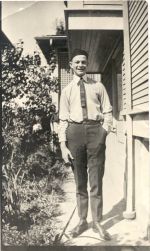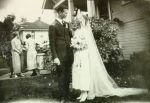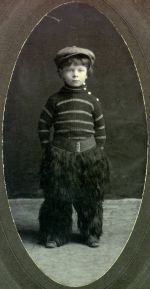
Early Years: Education, Teaching and the Chemical Bond
(Thomas Hager’s Force of Nature: The Life of Linus Pauling has served as a valuable guide to this material.)
The list begins with examples of early influences on Pauling and his thinking. Information on most-cited papers comes from "The Twenty-five Most Cited Publications of Linus Pauling" by Zelek B. Herman, in The Roots of Molecular Medicine, Richard P. Huemer, ed, 1986.
| 1900s | Childhood environment A Pictorial History of Gilliam County, where Condon, Oregon is located, and where Pauling lived for a time as a child. Biographical 5.004 (Catalogue Vol. IV page 76) |
| 1910 | Pauling's father writes local paper to request advice on reading for his son. Pauling referred often to this event in interviews. Also in Hager, Force of Nature, page 31. Newspaper Clippings 1910n.1 (Catalogue Vol. VI page 1). Also excerpted as an appendix to Vol. II of the published catalogue. |
| 1917 | Early diary Written at age 16. Biographical 1.001 Folder 1.1 (Catalogue Vol. IV page 1) |
| 1920 | Undergraduate at Oregon Agricultural College First undergraduate paper, "The Manufacture of Cement in Oregon." Publications 1920p.1 (Catalogue Vol. I page 105)  Linus Pauling at Oregon Agricultural College, wearing his "freshman beanie," ca. 1917. LP Photographs, 191?i.160 |
| 1921-1922 | Teaches while an undergraduate at Oregon Agricultural College An instructor in Pauling's physical chemistry course, Fred Allen, donated his class notebook to the Pauling Papers. In one of his chemistry courses, Linus taught Ava Helen Miller, whom he would later marry. View Online: Biographical 1.005 Folder 5.1(Catalogue Vol. IV page 2) |
| 1922 | Graduation from Oregon Agricultural College (later Oregon State University) Delivers Senior Class Oration. In this talk, Pauling affirmed the social responsibility of the scientist. Manuscripts and Typescripts of Speeches 1922s.1 (Catalogue Vol. I page 197) |
| 1922-1923 | In love with Ava Helen Miller; Linus and Ava Helen marry, 1923 A large collection of love letters includes correspondence from these early years. Linus quotes poetry and makes observations on his own life; the couple recommend books to each other. Safe Documents (Love Letters) (Catalogue Vol. IV page 255)  Linus and Ava Helen Pauling on their wedding day, Salem, Oregon, June 17, 1923. LP Photographs, 1923i.4 A sample of letters written while Pauling worked at his summer job as a road paving inspector:
|
| 1923 | Graduate study: works under Roscoe G. Dickinson at Caltech Dickinson was an important influence on Pauling’s crystallographic work, in part because he "rescued" Pauling from certain unsuccessful graduate experiments. When Pauling entered the California Institute of Technology as a graduate student in 1922, the Chemistry department had nine faculty members and seven graduate students. The Dickinson file includes course notebooks, correspondence and reprints. Correspondence 94.1-94.5 and 95.1 (Catalogue Vol. I pages 56-57) |
| 1923 | First paper as a graduate student: "The crystal structure of molybdenite" Written with Dickinson, whose suggestions enabled the success of the experiment. Publications 1923p.1 (Catalogue Vol. I page 105) |
| 1923 | First sole-author paper: "The crystal structure of magnesium stannide" One of several crystallography papers published by Pauling during his graduate years. Manuscripts and Typescripts of Articles 1923a.1 (Catalogue Vol. I page 153) Publications 1923p.2 (Catalogue Vol. I page 105) |
| 1920s | Early crystallographic research Research notebook with notes concerning first two papers (and on p.81, "I love you", written by Ava Helen – see p.104 of Tom Hager’s Force of Nature on Ava Helen as lab assistant). Covers 1922-24, with some notes from later years. View Online: Research Notebooks Box 2R(Catalogue Vol. II page 75) |
| 1920s | Early crystallographic research A series of notes in Pauling's early Research notebooks. (Catalogue Vol. II page 76) View Online: Research Notebooks Box 3R, 1923-25; Box 4R, 1924, 1926, 1928-29; Box 5R, 1924, 1929, 1933, 1935 |
| 1920s | Crystallography and quantum theory / Chemical bond Loose research notes and calculations, 1923-29; discussion of hybridization, 1928. Science 3.001 (Catalogue Vol. II page 6) |
Table of Contents
- Introduction
- Ways to Approach the Curriculum
- Using Archival Materials in Special Collections
- Early Years: Education, Teaching and the Chemical Bond
- Part I: 1901-1924
- Part II: 1925-1929
- Part III: 1930-1939
- Middle Years: War Work, Peace Work and Protein Structure
- Later Years: Molecular Disease and Orthomolecular Medicine
- Topical Readings
- Websites Regarding Linus Pauling
- Appendix: General Guidelines for Use of Special Collections Materials
- Acknowledgements



